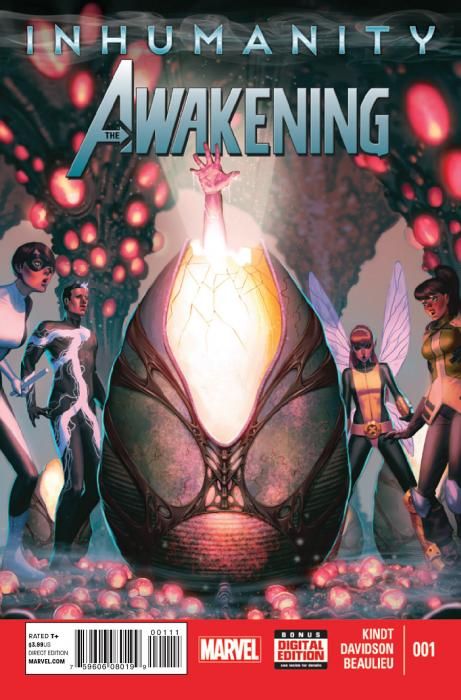Whatever your reaction "Inhumanity: The Awakening," credit to the creative team: they commit to their choices. Their going-for-it aesthetic creates both the issue's strongest and weakest moments, and while it doesn't result in a perfect final product, it does make the case for "Inhumanity: The Awakening" as a distinct title with its own distinct concerns. When so many spin-offs of big events can feel like they were produced out of obligation, a title with this passion and verve is much-appreciated.
Writer Matt Kindt has been deservingly lauded for his creativity in titles like "Mind MGMT", so it's no surprise that he's adventurous with format here. Hitting the "youth" element of this series hard, he incorporates two social media streams -- one of a recently-hatched Inhuman, and one of two commenters in the outside world -- to help tell the story. When these elements work, they're undeniably brilliant. For instance, when it's revealed that the outside commentary is actually from the future, the rush of foreshadowing is moving and shocking. In the same vein, the pseudo-Instagram account of the recently hatched Inhuman, Fiona, gives the reader a real sense of her as a person over a relatively short page count. Other times, the social media streams feel too cloying and proud of their own cuteness. They add a whole lot of text to every panel, and it gets tiresome to follow when they aren't adding anything of value.
Paul Davidson's art adds to the youthful and earnest vibe of this issue. The characters are all drawn with wide, large eyes so that even Pixie doesn't look exceptional. Joe Caramagna's colors occasionally do some strange things to the character's faces, but he does make nice use of color in the wider panels. with bright spots. There's a wonderful transition from the first panels, which open in sunless rubble with the dialogue "It's hopeless," to the first two-page spread in the light of day in Manhattan. When the students at the Jean Gray School and Avengers Academy are picking up the pieces in a ruined city, it doesn't look like a scene out of a disaster movie. It looks like a youth volunteer group cleaning up their neighborhood.
The four heroes of the issue are Pixie, Quentin, Striker and Finesse, but only Striker and Pixie get any real character moments. Pixie is the heart of the team who first identifies Fiona on her social media channels, while Striker ends up being the one to talk to Fiona. Striker's advice to Fiona is an interesting ode to our celebrity-obsessed culture, which popular criticism tends to decry, or at least worry over. Instead, Striker exults in it. His advice boils down to, "At least you're famous! Who cares why?" It's a very Striker response, but I don't know if it would really be an effective way to cope for Fiona.
The only larger problem in this issue is more of a problem with the Inhumanity event in general. The success of "Inhumanity: The Awakening" helps to establish the viability of the newfound Inhumans as emotional and narrative drivers, but by emphasizing their shared experiences with the students at the Jean Grey School and Avengers Academy, it doesn't do much to differentiate the new batch of Inhumans as a group in the Marvel Universe. Introducing a whole new class of superhuman suggests that they have something new to bring to the table, and "Inhumanity: The Awakening" only treads over familiar (if fertile) emotional ground.

